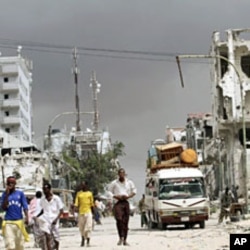Refugee camps in eastern Ethiopia are bracing for a wave of new arrivals from Somalia as fresh fighting aggravates already severe famine conditions. But fear appears to be replacing hunger as the main factor driving Somalis to flee their homeland.
The long-awaited rainy season has begun along the Ethiopia-Somalia border. Gray clouds hanging overhead raise hopes for an end to the drought that ruined the last few harvests, triggering famine in Somalia and severe food shortages across a broad swath of the Horn of Africa.
United Nations refugee agency officials say flooded roads may be a factor in a recent slowdown in the flow of refugees out of Somalia. Numbers have dropped from 500 a day to about 200 since the rains began.
But recent arrivals at the Ethiopian border point to other reasons for the drop. One resident of the Dollo Ado transit center who gave his name only as Abraham said al-Shabab rebels who control much of southern Somalia are mining roads and manning roadblocks to keep people from fleeing.
“The borders are blocked, but I fled anyway because we're afraid of being killed by al-Shabab," he said.
Mohamed Aden Osman, 22, was captured at an al-Shabab checkpoint while trying to flee, and held for two days. He says after being freed, he trekked through the desert for nine days to reach Ethiopia.
“Boys my age are just what they are looking for," he said. He told VOA he was taken to jail and only freed after he lied and said he was going back home.
Anne Laako, a UNHCR intake officer at the Dollo Ado refugee center, says interviews with new arrivals indicate that the harsh life under al-Shabab is becoming as much a factor as hunger in people's decision to flee Somalia.
"It's not only the drought and famine but it's restrictions of movement by al-Shabab, and those combined," said Laako. "It's more difficult to move to where they used to move to get food and water and these things."
Laako says the general health of the new arrivals is not as bad as it was a few months ago, when the refugee exodus was at its peak.
"It's better than it used to be. A couple months ago you could see people were in pretty bad condition and very severely malnourished but nowadays of course they're not well but they're not too bad either," Laako added.
Laako says after a long day of interviewing new arrivals, she often wonders how bad conditions must be in Somalia if people are choosing to trade their livelihoods for the harsh life of a refugee.
"It's difficult to stop thinking about it. I'm constantly thinking about it. And how the people are after they've been registered and if it's any better for them here than it is back in Somalia where they came from, and it is a very desperate situation," Laako said. "Here they [have] access [to] basic services but it's still a very difficult life. And the whole situation in Somalia, it doesn't seem like it's going to be solved any time soon."
Officials here say they are prepared for a new wave of refugees, based on the scanty information they get about developments inside Somalia.
Kenya this month sent troops into Somalia in pursuit of al-Shabab, which officials blame for a series of cross-border kidnappings. The militant group also lost ground recently in the capital, Mogadishu, to Somali government and African Union forces.
But al-Shabab has shown staying power in the face of pressure, and continues to control large portions of southern Somalia. Newly-arrived refugees say the insurgents are becoming increasingly desperate, and are trading their uniforms for civilian clothing to blend into the civilian population as Kenyan forces advance. The road to Dollo Ado remains treacherous.










